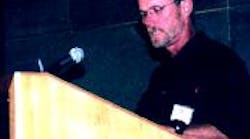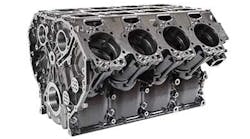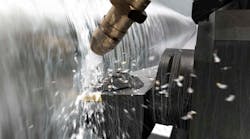International cutting tool manufacturers convene to address industry trends.
David Baker, president of both Robb-Jack Corp. and USCTI, gave his market presentation on the closing day of the conference.
Over a hundred USCTI, JCTA, and ECTA member companies were represented at the 2001 world conference for manufacturers of metalcutting tools.
The presidents of the three major world cutting-tool associations — David Baker (USCTI), Teruhide Osawa (JCTA), and Michael Childs (ECTA) — spoke about industry issues at the AMERICAN MACHINIST panel discussion.
The recent 2001 world conference for manufacturers of metalcutting tools gathered together members of the three major world cutting tool associations — the United States Cutting Tool Institute (USCTI), the European Cutting Tool Association (ECTA), and the Japan Cutting Tools Association (JCTA) — to discuss a number of issues important to the industry. Industry leaders provided international perspectives on such issues as economic trends, cutting tool development and technology, and e-business and distribution.
The conference began with a presentation on U.S. trends and market development by
Robert McKee, president of Talbot Holdings. In his presentation McKee said, "The speed and severity of this current economic downturn is one of the worst I've seen in the U.S." Mc-Kee, unlike economists looking mainly at gross domestic product growth, believes that the U.S. manufacturing economy is in a recession. He bases his beliefs on industrial production rates, which show three consecutive quarters of negative growth — starting in the second quarter of this year and the third and fourth quarter of last.
But economic challenges are not limited to the U.S. In other countries throughout the world, 2001 figures are below those from 2000, and he warned that all cutting tool manufacturers are "facing some tougher economic times than we've had in the last few years."
According to McKee, manufacturers will react to this recession with an investment in technology, continued globalization, and expanded partnerships. With investment in new technology, machine tool builders will make new machines faster and more rigid and cutting tool manufacturers will continue to produce higher-performance carbide tools.
Cutting tool companies will have to focus globally, McKee said, in part because of increasing outsourcing trends, which will require servicing customers and their processes wherever they are located in the world. This globalization is expected to make supply-tool management more important since, according to McKee, "getting the right parts, to the right customer, at the right time," is paramount in reducing overhead.
Finally, McKee believes this new economic condition will spur on growth in customer part-nerships — better back-end support and process development, design collaboration, and supply management.
"We're going to be more involved in our customers' processes then we have before. Customers are going to survive by changing the way they do business. The question is, 'Will we change the way we do business?'"
Many economic issues facing Europe are the same as those in the U.S., but Jeremy Peat, group chief economist at the Royal Bank of Scotland, used his presentation to address some special challenges faced by the European Union. He discussed the need for mutual recognition of standards worldwide and the importance of enforcing the EU directives. There are 1,459 EU directives, but unfortunately directives and other issues often fall through the cracks because the board of directors changes every six months. "That's a problem," said Peat. "We have two faces of membership — the 12 in the Euro zone and the three that are not in the Euro zone. And even in the Euro zone, where we have standards for interest rates and inflation, our rich mix of cultures isn't conducive to rigid economic management." Peat also stated that the entire EU needs to switch over to a single currency, but he acknowledged the difficulty the Euro faces at the moment with its weak exchange rate.
AMERICAN MACHINIST panel discussion
The exploration of trends affecting the industry extended beyond economic issues in the conference's fourth day, when AMERICAN MA-held a roundtable discussion with the presidents and key members of the USCTI, ECTA, and JCTA. The panel members elaborated both on the conference's success and on issues like consolidation, association effectiveness, globalization, and statistics standards.
Everyone involved in the roundtable felt that the current conference had a broader focus compared to its predecessor, but each added that it was no less technical. That broader focus meant talking about machine tool builders, tool and spindle makers, and cutting tool companies coming together to offer a complete solution to market.
Because of the second conference's success, many were wondering about a potential third conference. USCTI president David Baker said that preliminary planning had already begun and stated, "The issue is not whether to have it; it's where." JCTA president Teruhide Osawa used the roundtable forum to express his hesitation about having the next conference in Asia.
"People might be expecting the third conference to be in Asia. But when you look at the bulk of cutting tool trade-association membership at this time, I think there are 270 member companies total, and half of those are from the U.S. Europe takes up another eighth of that total. Because Asia is so far away, we don't think it's wise to do it there. To have successful attendance, it should stay in the U.S. or Europe," said Osawa.
Conference goers were already looking forward to a third conference in order to learn even more from each other and begin working more closely in a global economy. The first statement from the President of ECTA, Michael Childs, was a call for higher levels of cooperation. "I think it is interesting that we know a lot about our own market, but when we look at statistics and the size of markets in other countries, we actually know very little. But if we can get together and share information, I think the industry will be stronger."
Childs also challenged the way cutting tool manufacturers view and label themselves within the industry — recommending that firms stop identifying with the materials they manufacture and instead focus on classifying themselves according to the customers they serve.
"This man is a carbide man; this man is a high-speed steel man. That's how we split, rather than, how do we serve the die and mold industry or how do we serve aerospace," said Childs.
Baker admitted that the fiercely competitive nature of industry leaders would hold back partnerships, but he believes that more partnering should be done for research-and-development efforts.
Baker stated, "No cutting tool companies collaborate with each other for research and development. The only collaborative effort for R&D is between companies and universities. But cutting tool companies do collaborate with machine tool builders."
And that machine tool builder collaboration was the stated partnership priority of everyone at the conference. Osawa commented that, as machines become more sophisticated, machine tool builders need to partner with cutting tool manufacturers. And with the question of machine tool and cutting tool partnerships being addressed, there was another question introduced: Who is offering more advanced technology — the machine tool builders or the cutting tool manufacturers? The answer came from Childs, who had made an earlier statement about cutting tool companies producing more advanced technology than their machine tool counterparts.
"What I meant is that there is currently a fragmented interface between the user requirement, the cutting tool manufacturer, and the machine tool manufacturer, " explained Childs. "We have to work in harmony. More and more these days we are being asked to look at specific applications without knowing the customer. That means we're developing tooling for that customer and application in isolation, and if we don't get together with the machine tool, spindle, and tool-holding people, then our efforts and solutions will continue to be fragmented," he said.
Baker added that the technology in both these industries was cyclical.
"Over the years," said Baker, "people have said that either cutting tool or machine tool makers have been ahead, and I imagine that trend will continue. As machine tool builders develop technologies that let machines run faster or more accurately or efficiently, the cutting tool people need to catch up with tools that can keep up with those advancements. Historically, cutting tool companies develop more advanced tooling and surpass machine tool technology. Eventually, the cycle shifts and the machine tool technology exceeds the cutting tool technology. It's hard to know at any given time who's actually leading, but I think right now we're pretty even."
The discussion of technology and its advancement opened the floor up to talks about standards and the need to have worldwide agreements, especially in relation to statistical reporting within the industry. Many felt there was a need for more refinement in statistical practices, commenting that current statistics sometimes portray an inaccurate picture of the industry.
According to Osawa, "The statistics are too fractionalized. The categories are not clear. Each company has its own tiers. But to study worldwide activity on a deeper level, we should make a formula for the statistics."
Childs agreed that there was a need for more "honest" statistics, saying that while the statistics are mostly accurate, they are confusing and perhaps organized poorly. He also pointed out that differently labeled cutting tools were doing the same applications worldwide.
"If we don't, as associations, do anything else within the next 10 years, we should work on putting statistics together and looking at standards that we have in the industry. Because if we're confused, our end users and customers must be terribly confused," Childs said.
The exact purpose and effectiveness of the different worldwide cutting tool associations was also a topic for debate. All agreed that the USCTI is a good example of how to run and efficient and effective association. The British cutting tool association is also happy with the workings of its nation's organization, but Childs commented that he hoped that ECTA could catch up in efficiency.
"ECTA has a wonderful bureaucracy, but that's where it ends. We have a lot of great case instructors in place to encourage cooperation, but we are six country-based associations that are pulled together only once a year. And that's the problem," he said. "Un-like the USCTI, the ECTA's strength lies not in the association's structure but in the countries that form the association. And only getting together once a year means we miss great opportunities to take care of European-wide issues. But our friends in the machine tool industry have shown us the way it can be done with the CECIMO organization."
When asked about top concerns in the industry, all three association leaders shared their frustrations with rising raw material prices, especially carbide.
Osawa was also concerned about exchange rate issues, and Baker lamented the rising cost of healthcare in the States and the negative effect that it was having on industry.









